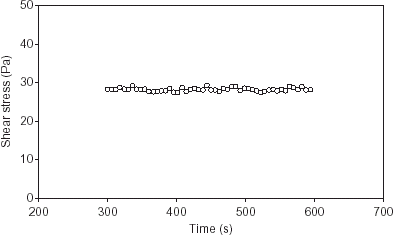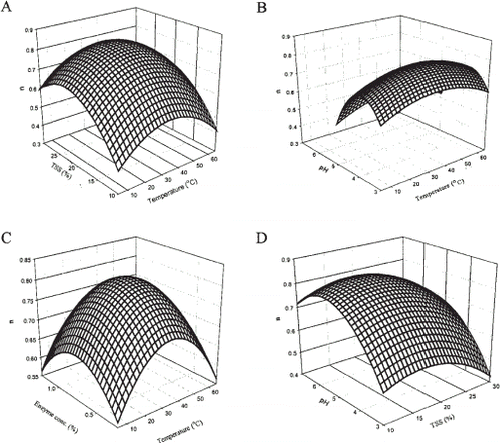Abstract
The individual and interactive effects of temperature (5–65°C), total soluble solids (TSS) (10–30°Brix), pH (3–7), and α-amylase concentration [(0.25–1.25)kg 100 kg−1 puree] on rheological characteristics of papaya (Carcia papaya L.) puree were studied by the application of the response surface methodology (RSM) using a computer controlled rotational viscometer. Papaya puree exhibited pseudoplasticity with yield stress and flow following Herschel-Bulkley model. A quadratic model developed for rheological parameters met all the criteria of good fit and provided information for characterizing the effect of different variables. It was observed that temperature, TSS and pH individually and in combination affected consistency index (P<0.05) while flow behavior index was significantly influenced by all four factors (P<0.05). The temperature and enzyme concentration considerably affected apparent viscosity.
Introduction
Knowledge of the rheological properties of food products is essential for the product development, design and evaluation of the process equipment such as pumps, piping, heat exchangers, evaporators, sterilizers, and mixers. Rheological measurements have also been considered as an analytical tool to provide fundamental insights on the structural organization of food. Numerous studies have been conducted on the rheological properties of fruit and vegetable products.Citation1 Citation2 Citation3 Citation4 Citation5 Citation6 Citation7 Various factors affecting the rheological behavior of fruit purees and concentrates include temperature,Citation8 Citation9 Citation10 total soluble solids (TSS)/concentration,Citation1 Citation11 Citation12 Citation13 particle size,Citation14 Citation15 addition of enzyme,Citation2 Citation16 and pH.Citation17 It has been reported that fruit purees behave as non-Newtonian fluid as a result of complex interactions among soluble sugars, pectic substances, and suspended solidsCitation9 and therefore rheological parameters of various fruit purees are needed for research and engineering applications as design and optimization of processing units.
Various rheological models have been used to represent the flow behavior of pureed foods. The power law model is one most commonly used to describe the flow of food products without yield stress, while Casson and Herschel-Bulkley models have been employed for foods with definite yield stress. Concentrated fruit pulps exhibit flow properties, which depend on time as well as shear rate. Fruit juices are mostly Newtonian in nature and commonly represented by power law model (flow behavior index=1.0). Fruit juice concentrates and purees with higher total soluble solids have been well described by Herschel-Bulkley model.Citation16 Citation18 Citation19 Citation20
Papaya (Carcia papaya L.) is an important fleshy fruit of the tropics and is an excellent source of vitamin A and C. The fruit has attracted attention of the food processors and some processes for preservation of fruits have been reported.Citation21 Citation22 Papaya is processed into various forms after the extraction of pulp. Puree is one of the important intermediate papaya products, which is thermally processed and stored for the manufacture of beverage, ice-cream, jam, jelly, among other products.Citation6
The response surface methodology (RSM) is a statistical method with an empirical modeling techniqueCitation23 used to find the optimum condition of a process response variable. The technique deals with the process which is not well understood or it is too complicated to allow the best model to be formulated from theory. It evaluates the existing relation between a group of controlled experimental factors and the observed results of one or more selected variables.Citation24 The central composite rotatable design (CCRD) has the advantage to predict responses based on selected experimental data wherein all factors are varied within a chosen range. Numerous applications of the RSM technique in food processing and research are available in the literature.
The objective of this work was, therefore, to evaluate the suitability of the RSM to study the effects of temperature (5–65°C), TSS (10–30°Brix), pH (3∼7), and α-amylase concentration [(0.25–1.25) kg kg−1 of solids] on rheological characteristics of papaya puree.
Materials and Methods
Preparation of Puree
Papayas of Solo variety were procured from a departmental store of Montreal city; washed thoroughly and exposed to flowing steam for 2 min to coagulate the latex in the peel and inactivates the enzymes in the peel.Citation21 The skin was removed using a stainless steel knife. The fruit was cut into two pieces and the seeds were separated. The pulping was done in a laboratory size food processor (Osterizer, Sunbeam Corporation Ltd., Canada) and passed through a paddle finisher fitted with a sieve of 100 mesh (D'errioo, Canada) to remove fiber leading to puree of uniform consistency. The obtained puree was stored in a sterile glass container at 0°C before use. Total soluble solids and pH of papaya puree were 10.2°Brix and 5.11, respectively. The average proximate compositionCitation25 of papaya puree were: 89.05% moisture, 0.31% protein (N×6.25), 0.22% fat, 0.32% ash, and 0.94% crude fiber; the starch content was 1.96%.
Experimental Design
Response surface methodology was selected to investigate the main effect of the process variables on rheological characteristics of papaya puree. The experimental design adopted was a modified configuration of Box's central composite design (CCD) for four variables at five levels each (Table ). The four independent variables or factors (temperature, TSS, pH, and α-amylase concentration) were selected to optimize responses consistency index (Y1), flow behavior index (Y2), and apparent viscosity (Y3). The complete design included 31 experiments with seven replications of the center point (Table ), and was rotatable as described by DraperCitation26 and Chen and Ramaswamy.Citation27
Table 1 Variables and levels for a rotatable central composite design used in papaya puree rheology experiments
Table 2 Central composite rotatable design arrangement and responses
Sample Preparation
As per the design described above, the samples were prepared by addition of required amount of sugar, citric acid, sodium hydroxide, and α-amylase respectively. The samples were incubated for 6 hours at 37°C to obtain maximum enzyme activity. Sugar was procured from a departmental store while citric acid, sodium hydroxide, and fungal crude α-amylase enzyme (Type X-A; EC 3.2.1.1; Lot 61H0531 from Aspergillus oryzae) were purchased from Sigma Chemicals Company (St. Louis, MO). Total soluble solids (°Brix) and pH were determined using a Refractrometer (Atago, Japan) at 20°C and a pH meter with glass electrode (Accumet, USA).
Rheological Measurement
A rotational viscometer (Haake Model RV20; Haake Mess-Technik, Karlsrulhe, Germany), equipped with an M-05 OSC measuring head and MV1 rotor (o.d. 20.04 mm and height 60 mm) in a concentric cylindrical cup (i.d. 21 mm) assembly interfaced to a microcomputer for control and data acquisition was used for rheological measurement. The sample compartment was maintained at a constant temperature using a water bath/circulator (Haake, Model FK-2).
For each test, the filled sample cup and spindle were temperature equilibrated for about 15 min and the samples were subjected to three-cycle shear changes from 0 to 300 s−1 in 5 min, steady shear at 300 s−1 in 5 min followed by back to 0 s−1 in next 5 min. The rheograms were evaluated by the software (Haake RV20 version 2.3) using the Herschel-Bulkley model [Eq. (Equation1)]. Yield stress values were obtained directly from the software as well as verified from Casson model [Eq. (Equation2)]. The apparent viscosity was computed as the ratio of shear stress to shear rate (τ/γ) at the mid shear rate of 150 s−1.
where τ is the shear stress (Pa), τ 0 is the yield stress, γ is the shear rate (s−1), K is the consistency index (Pa s n ), and n is the flow behavior index (dimensionless), K 0 and K c are Casson yield stress and Casson constant, respectively. Yield stress was calculated from the relationship K 0 2=τ 0.
Polynomial Equations and Statistical Analysis
A quadratic polynomial regression model was assumed for predicting individual Y variables. The model proposed for each response of Y is:
The regression analysis, analysis of variance (ANOVA), canonical analysis, and analysis of ridge maximum of data were carried out using the RSREG procedure of the SAS statistical packageCitation28 to fit second order polynomial equations for all response variables. Response surfaces were made by the fitted quadratic polynomial equation obtained from RSREG analysis, holding the independent variables with the least effect on the response at a constant value, and changing the other two variables. Conformity experiments were done to validate the equation, using the combination of independent variables, which were not included in the original experimental design and within the experimental region. Lack-of-fit tests were performed on the fitted models. Coefficients for the linear, quadratic, and interaction terms of each model were calculated and tested from zero. The criteria for eliminating a variable from the full regression equation was based on R 2 values, standard error (SE) estimate and significance F-test and the derived P values. Three dimensional response surface plots were generated by using Sigma plot software (Sigma Plot 2000; SPSS Inc.) to illustrate the main and interactive effects of the independent variables.
Results and Discussion
Rheological Characteristic of Papaya Puree
All test samples of papaya puree characteristically exhibited a yield stress and therefore the shear stress–shear rate data were fitted to the Herschel-Bulkley model rather than the conventional power law model. For all cases, R 2 values were greater than 0.94 and SE were less than 0.09. Differences between the yield stress data computed from instrument software and those calculated from Casson model were not significantly different (P>0.05). Yield values are presented in Table . Typical rheological flow curve for papaya puree is shown in Fig. . Upward and downward curves essentially gave similar results and hence average values of rheological parameters between upward and downward curves were used. The flow behavior index of papaya puree was less than unity and hence the puree represented a pseudoplastic fluid. Pseudoplasticity has similarly been observed for fruit purees by various researchers.Citation16 Citation18 Citation20
Figure 1. Typical shear stress–shear rate curve for papaya puree at selected conditions. Set-1: 20°C, pH 6, 15°Brix, and 0.8% α-amylase concentration; Set-2: 35°C, pH 5, 20°Brix, and 0.6% α-amylase concentration; Set-3: 50°C, pH 6, 15°Brix, and 0.8% α-amylase concentration; Set-4: 20°C, pH 5, 35°Brix, and 1% α-amylase concentration.
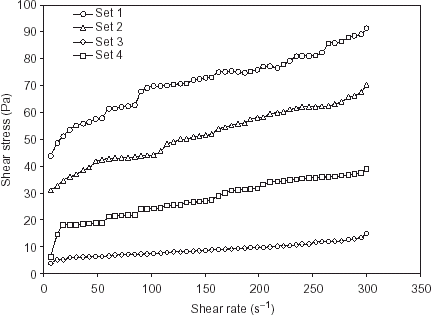
Figure shows the time dependency rheology curve of papaya puree as a shear stress vs. time relationship at the peak shear rate of 300 s−1. The observed shear stress at a specific shear rate was not sensitive to the time of shear. Therefore, the puree viscosity was considered to be time-independent within range of test conditions employed in the study.
Regression Models of Rheological Parameters (Consistency Coefficient, Flow Behavior Index, and Apparent Viscosity)
From a practical standpoint, it will be more relevant to describe the effects of temperature, TSS, pH, and α-amylase concentration by one combined model. In the literature, the Arrhenius model has been most widely used to describe the effects of temperature, while the effect of concentration has been described by either an exponential or a power relationship. Several authorsCitation2 Citation11 Citation12 Citation20 Citation29 used the combined effect of temperature and total solids content on consistency index/apparent viscosity to describe the flow behavior of concentrates or pureed fruits and vegetables. However, none of the above studies takes into account the effects of pH and enzyme concentration on the rheological properties of papaya puree. In this study, K, η, and n were expressed as a function of temperature and concentration through a multiple regression analysis.
The effects of treatment variables as linear, quadratic, or interaction coefficients on response variables were obtained by ANOVA (Tables and ). Significance of the lack-of-fit error term, R 2 value, coefficient of variation (CV), and model significance were used to judge adequacy of model fit. The predictive models developed for Y1, Y2, and Y3 of papaya puree were considered adequate because the associated lack of fit was not significant for these cases and they had satisfactory levels of R 2, CV, and model significance. It is evident from Table that all linear, quadratic, and interaction terms were significant (P<0.05) for Y1; X1, X4 and quadratic terms of X1, X3 and X4 were significant for Y3 while interaction term was insignificant for Y2. The R 2 values were 0.93, 0.85 and 0.81 for Y1, Y2 and Y3, respectively while SE was less than 0.11 for all the cases. The contribution for linear, quadratic, and cross products terms to the model was 0.633, 0.141, and 0.132 for Y1; 0.320, 0.410 and 0.068 for Y2 and 0.323, 0.388 and 0.095 for Y3, respectively.
Table 3 Analysis of variance of the second order polynomial model for consistency index, apparent viscosity, and flow behavior index of papaya puree
Table 4 Regression coefficients and analysis of variance of the regression models for rheological parameters
The fitted equations were obtained considering only significant terms to predict Y1 (K), Y2 (n), and Y3 ( η ) values and are shown below:
Effects of Temperature, Total Soluble Solids, and pH on Consistency Index
The model [Eq. (Equation4)] indicated that temperature (X1) had significant effect (P<0.05) on Y1 as it had the largest coefficient followed by TSS (X2) and pH (X3). These observations were also verified from canonical analysis of response surface. Negative coefficients of X1 and X2 indicated linear effect to decrease Y1. However, X3 had positive effect along with quadratic terms (X12 and X22) and interaction terms (X1X2 and X2X3) that increased Y1. No significant effect (P>0.05) was observed for enzyme concentration (X4) on Y1. It could be due to interference of pH as the α-amylase enzymes were sensitive to pH. The three-dimensional figures (Fig. ) show that the three independent variables and their interactions of the predictive model for consistency index. These provide geometrical representation of the behavior of K within the experimental design. The minimum consistency was observed with increase in TSS and temperature while lower pH and higher TSS resulted in optimum consistency index.
Figure 3. Response surfaces for the effect of temperature, TSS, and pH on consistency index (K) of papaya puree.
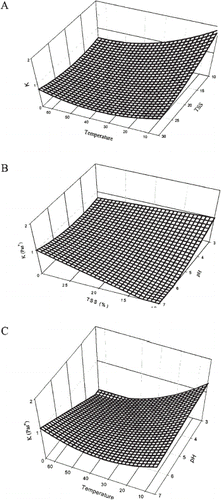
The consistency index decreased with increase of temperature and TSS. But the extent of increases or decreases of K at different temperatures or TSS were different because of the interaction between independent variables. Decrease in K with an increase of temperature and increase in K with concentration are commonly reported by researchers.Citation1 Citation10 Citation13 In our case the reverse trend was noticed as added sugar increased TSS with decrease in consistency index significantly (P<0.05). The optimum temperature and TSS to get minimum consistency index was calculated from partial derivatives of the quadratic response equation with respect to X1 and X2, setting the derivatives equal to zero. It was found to be 48°C and 26°Brix, respectively. The eigen values obtained from the canonical analysis were 50% positive and 50% negative, thus indicating that the stationary point is a saddle point.
Effects of Temperature, Total Soluble Solids, pH, and Enzyme Concentration on Flow Behavior Index
It is evident from Eq. (Equation5) that Y2 was dependent (P<0.05) on all the four factors or its quadratic terms. However, no interaction term was found to be significant. Canonical analysis revealed that pH (X3) had maximum effect followed by TSS (X2) and enzyme concentration (X3) on Y2. The negative coefficient of pH (X3) and quadratic terms (X12, X22, X32, and X42) decreased the magnitude of Y2 while TSS (X2) linearly increased. Figure shows the effects of interaction between temperature–TSS, TSS–pH, and temperature–pH on flow behavior index. The figures (A–D) show that n increased with process temperature, TSS, and addition of enzyme. Low pH values and high TSS increased flow behavior index (Fig. B, C). However the variation was not systematic due to interaction of other factors. The optimum TSS and pH for better flow behavior index were found to be 23°Brix and 4.4, respectively. All eigen values obtained for analysis were negative, thus indicating that the stationary point for the response was maximum.
Effects of Temperature, pH, and Enzyme Concentration on Apparent Viscosity
Equation Equation6 shows that temperature (X1) and enzyme concentration (X4) significantly (P<0.05) influenced the Y3. The negative linear coefficients of X1 and X4; quadratic coefficients of X1, X3, and X4 decreased Y2. No significant effect was observed for TSS (X4) or any interaction terms on Y2. The three-dimensional figures (Fig. ) show that the independent variables of the predictive model for apparent viscosity with its geometrical representation. Temperature and enzyme concentration reduced the magnitude of η. The addition of α-amylase enhanced the liquefaction of papaya puree with temperature. This observation is supported by earlier reports.Citation2 Citation10
Figure 5. Response surfaces for the effect of temperature, α-amylase concentration, and pH on apparent viscosity (η) of papaya puree.
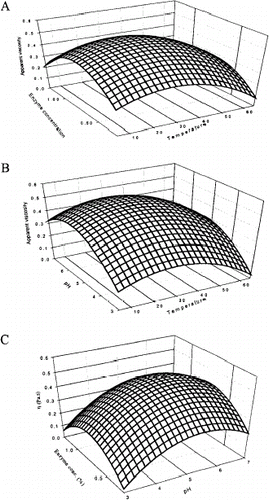
The data obtained for minimum apparent viscosity were 24.3°C temperature and 0.665% enzyme concentration, respectively. Canonical analysis indicating that the stationary point is a saddle point (75% negative values) and the processing variables were located within the experimental range implying that the analytical techniques could be used to identify their minimal condition.
Conclusions
The RSM was effective to optimise the rheological behavior of papaya puree and three-dimensional figures well represented to identify the effects of temperature, TSS, pH, and enzyme concentration on rheological parameters of papaya puree. Good fit models were developed for consistency index and flow behaviour index. The importance of the process variables on the flow characteristics could be ranked in the following order: the temperature (X1)>total soluble solids (X2)>pH (X3)>α-amylase concentration (X4). The optimum temperature and TSS for consistency index were found to be 48.4°C and 26°Brix respectively while optimum TSS and pH for flow behavior index was 23°Brix and 4.4, respectively. The apparent viscosity was optimised at 0.665% enzyme concentration at 24.3°C. The flow behaviour was described well by Herschael-Bulkley model and papaya puree behaved as a pseudoplastic fluid with yield stress.
References
- Rao , M.A. 1977 . Rheology of liquids foods—a review . J. Texture Stud. , 8 : 135 – 168 .
- Khalil , K.E. , Ramakrishna , P. , Nanjundaswamy , A.M. and Patwardhan , M.V. 1989 . Rheological behaviour of clarified banana juice: effect of temperature and concentration . J. Food Eng. , 10 : 231 – 240 . [CROSSREF]
- Truong , V.D. and Walter , W.M. 1994 . Physical and sensory properties of sweet potato puree texturized with cellulose derivatives . J. Food Sci. , 59 : 1175 – 1180 .
- Godfrey , U.A.M. , Bourne , M.C. and Rao , M.A. 1995 . Blanch temperature–time effects on rheological properties of applesauce . J. Food Sci. , 60 : 1289 – 1291 .
- Bhattacharya , S. 1999 . Yield stress and time dependent rheological properties of mango pulp . J. Food Sci. , 64 : 1029 – 1033 .
- Ahmed , J. , Shivhare , U.S and Sandhu , K.S. 2002a . Thermal degradation kinetics of carotenoids and visual color of papaya puree . J. Food Sci. , 67 : 2692 – 2695 .
- Ahmed , J. , Shivhare , U.S and Debnath , S. 2002b . Color degradation and rheology of green chilli puree during thermal processing . Int. J. Food Sci. Tech. , 37 : 57 – 64 . [CSA] [CROSSREF]
- Saravacos , G.D. 1970 . Effect of temperature on viscosity of fruit juices and purees . J. Food Sci. , 35 : 122 – 125 .
- Holdsworth , S.D. 1971 . Applicability of rheological models to the interpretation of flow and processing behaviour of fluid food products . J. Texture Stud. , 2 : 393 – 418 .
- Vitali , A.A. and Rao , M.A. 1984 . Flow properties of low pulp concentrated orange juice: effect of temperature and concentration . J. Food Sci. , 49 : 882 – 888 .
- Harper , J.C. and El-Sahrigi , A.F. 1965 . Viscometric behaviour of tomato concentrates . Food Technol-Chicago , 30 : 470 – 476 .
- Ilicali , D.R.C. 1985 . Correlation for the consistency coefficients of apricot and pear purees . J. Food Eng. , 8 : 47 – 51 .
- Hernandez , E. , Chen , C.S. , Johnson , J. and Carted , R.D. 1995 . Viscosity changes in orange juice after ultrafiltration and evaporation . J. Food Eng. , 25 : 387 – 396 . [CROSSREF]
- Tanglertpaibul , T. and Rao , M.A. 1987 . Rheological properties of tomato concentrates as affected by particle size and methods of concentration . J. Food Sci. , 52 : 141 – 145 .
- Ahmed , J. , Shivhare , U.S. and Singh , G. 2000 . Chlorophyll and color of green chilli puree as affected by mesh size and temperature . Int. J. Food Prop. , 3 : 305 – 315 .
- Bhattacharya , S. and Rastogi , N.K. 1998 . Rheological properties of enzyme-treated mango pulp . J. Food Eng. , 36 : 249 – 262 . [CROSSREF]
- Dik , T. and Ozilgen , M. 1994 . Rheological behaviour of bentonite-apple juice dispersions . Lebensm. Wiss. Technol. , 27 : 55 – 58 . [CROSSREF]
- Duran , L. and Costell , E. 1982 . Rheology of apricot puree: characterization of flow . J. Texture Stud. , 13 : 43 – 58 .
- Ramaswamy , H.S. , Basak , S. and van de Voort. 1994 . Effect of strawberry concentrate on applesauce rheology . Canadian Agricultural Engineering Journal , 36 : 109 – 116 .
- Ibarz , A. , Giner , J. , Pagan , J. , Gimeno , V. and Garza , S. 1995 . Rheological behavior of kiwi fruit juice concentrates . J. Texture Stud. , 26 : 137 – 145 .
- Brekke , J.E. , Chan , H.T. Jr. and Cavelloto , O.G. 1972 . Papaya puree: a tropical flavor ingredient . Food Prod. Dev. , 6 : 36
- Chan , H.T. Jr. , Kuo , M.T.H. , Cavaletto , C.G. , Nakayama , T.O.M. and Brekke , J.E. 1975 . Papaya puree and concentrate: changes in ascorbic acid, carotenoids and sensory quality during processing . J. Food Sci. , 40 : 701 – 703 .
- Myers , R.H. and Montgomery , D.C. 1995 . Response Surface Methodology New York : John Wiley & Sons, Inc. .
- Box , G.E.P. , Hunter , W.G. and Hunter , J.S. 1978 . Statistics for Experimenters New York : John Wiley & Sons,Inc. .
- AOAC. 1980 . Official Methods of Analysis, , 13th Ed. Washington, D.C. : Association of Official Analytical Chemists .
- Draper , N.R. 1982 . Center points in second order response surface designs . Technometrics , 24 : 127 – 133 . [CSA]
- Chen , C.R. and Ramaswamy , H.S. 1999 . Rheology of topica starch . Food Res. Int. , 32 : 319 – 325 . [CROSSREF]
- SAS Institute, Inc. 1990 . SAS User's Guide Statistics, Version 5, , 4th Ed. Cary, NC : SAS Institute: Inc. .
- Rao , M.A. , Cooley , H.J. and Vitali , A.A. 1984 . Flow properties of concentrated juices at low temperature . Food Technol. , 38 : 113 – 119 .
